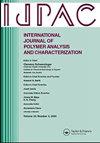龙舌兰纤维增强复合材料的结构、力学、热特性及复合螺旋压缩弹簧的有限元分析
IF 1.6
4区 工程技术
Q4 POLYMER SCIENCE
International Journal of Polymer Analysis and Characterization
Pub Date : 2025-05-06
DOI:10.1080/1023666X.2025.2496306
引用次数: 0
摘要
尽管已经研究了一系列的应用,剑麻纤维增强复合材料在螺旋压缩弹簧的使用是罕见的。因此,这项特别的研究表明,为了进一步促进可持续工程的发展,用轻质复合弹簧取代传统金属弹簧是可行的。这项研究的重点是成功地制造了螺旋压缩弹簧,使用长丝缠绕工艺-一种不太常用的方法应用于此类组件。复合材料的抗拉强度为66.74 MPa,抗折强度为70.47 MPa。通过FESEM和EDX分析了复合材料的表面形貌和元素组成。DSC分析发现热事件的起始温度为351.7℃,结束温度为392.8℃。峰下面积代表吸收的能量,为100.4 J/g,表示复合基体交联过程中所涉及的热量。热重分析显示复合材料在~ 30°C到~ 300°C之间具有稳定性。在300℃左右,残余重量显著下降,表明复合材料分解。采用长丝缠绕工艺设计并制作了螺旋压缩弹簧。利用SolidWorks软件建立了弹簧的三维模型,利用ANSYS软件对弹簧进行了有限元分析。结果显示,在35牛的情况下,该材料的最大刚度为1.87牛/毫米,验证了该材料的低强度应用。未来的工作应该是优化纤维-基质的相互作用,并研究轻型悬架系统、减振部件和其他环保汽车行业的复合材料。本文章由计算机程序翻译,如有差异,请以英文原文为准。
Structural, mechanical, thermal characterizations of Agave sisalana fiber- reinforced composite and finite element analysis of composite helical compression spring
Despite having been studied in a range of applications, the use of sisal fiber-reinforced composites in helical compression springs is rare. Thus, this particular study shows the feasibility of replacing conventional metal springs with lightweight composite springs in the interest of furthering sustainable engineering. This study focused on the successful fabrication of a helical compression spring using the filament winding process – a method not very commonly applied to such components. The tensile strength of 66.74 MPa and flexural strength of 70.47 MPa composite specimens were found. The surface morphology and elemental compositions of the composite were found through FESEM and EDX. The DSC analysis found the onset temperature of the thermal event begins at 351.7 °C and ends at 392.8 °C. The area under the peak, representing the energy absorbed, is 100.4 J/g, indicating the amount of heat involved during crosslinking of the composite matrix. The TG analysis revealed the stability of the composite from ∼30 °C to ∼300 °C. Around 300 °C, there is a significant drop in residual weight, indicating decomposition of the composite. The helical compression spring was designed and fabricated through the filament winding process. A 3D model of the spring was developed using SolidWorks and finite element analysis (FEA) of the spring was done using ANSYS. The results revealed a maximum stiffness of 1.87 N/mm at 35 N, validating the material for low-strength applications. Future work should optimize fiber–matrix interaction and study the proposed composite for lightweight suspension systems, vibration-damping components, and other eco-friendly options in the automotive industries.
求助全文
通过发布文献求助,成功后即可免费获取论文全文。
去求助
来源期刊
CiteScore
3.50
自引率
5.30%
发文量
37
审稿时长
1.6 months
期刊介绍:
The scope of the journal is to publish original contributions and reviews on studies, methodologies, instrumentation, and applications involving the analysis and characterization of polymers and polymeric-based materials, including synthetic polymers, blends, composites, fibers, coatings, supramolecular structures, polysaccharides, and biopolymers. The Journal will accept papers and review articles on the following topics and research areas involving fundamental and applied studies of polymer analysis and characterization:
Characterization and analysis of new and existing polymers and polymeric-based materials.
Design and evaluation of analytical instrumentation and physical testing equipment.
Determination of molecular weight, size, conformation, branching, cross-linking, chemical structure, and sequence distribution.
Using separation, spectroscopic, and scattering techniques.
Surface characterization of polymeric materials.
Measurement of solution and bulk properties and behavior of polymers.
Studies involving structure-property-processing relationships, and polymer aging.
Analysis of oligomeric materials.
Analysis of polymer additives and decomposition products.

 求助内容:
求助内容: 应助结果提醒方式:
应助结果提醒方式:


